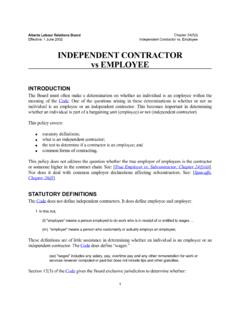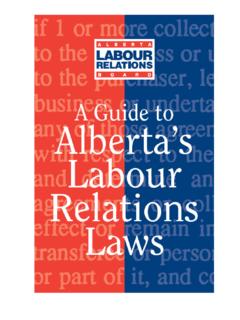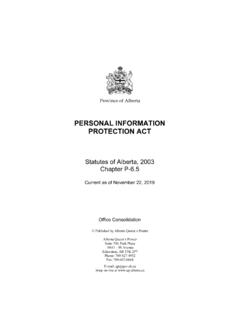Transcription of TELEPHONE PROCEDURES - Alberta
1 Alberta Labour Relations Board Chapter 12(b) Effective: 1 January 2003 TELEPHONE PROCEDURES TELEPHONE PROCEDURES INTRODUCTION This policy discusses the responsibilities associated with the Labour Relations Board s TELEPHONE system.
2 It discusses: TELEPHONE etiquette; the TELEPHONE system; incoming call; types of inquiries; outgoing call; and conference calls. The Receptionist is primarily responsible for the Board s TELEPHONE system. The Board receives many inquiries from the public. Below are some TELEPHONE guidelines a receptionist should follow. TELEPHONE ETIQUETTE Answer the phone by the second ring. Answer the phone with Good morning (or afternoon), Labour Relations Board. There is a great deal of confusion among the public about the Labour Relations Board and who we are.
3 The public often refers to us as Labour Standards and confuses us with the Employment Standards Branch. Messages are important. Keep them neat, get the caller s name, association, number (including area code) and, perhaps, file numbers and reasons for calling. See Messages below. Don t keep callers on hold for extended periods. Get back to them and ask if they still want to hold, or would like to leave a message instead. Avoid telling callers they must do something or have to call employment standards.
4 People prefer suggestions to orders. Try saying The agency that is set up to help you is called Employment Standards I suggest you give them a call at 427-3731. THE TELEPHONE SYSTEM Screening Calls: Most staff prefer to know who is calling before they take the call. This allows them time to locate appropriate files on the case at hand. For the Chair, Vice-Chairs, Director, Managers, and Legal Counsel, get the caller s name, and if possible, what file or matter they are involved in.
5 Try and make the caller feel you are being helpful, not that the person they want is trying to avoid their call. Screening calls for officers or administration staff is not necessary. 1 Alberta Labour Relations Board Chapter 12(b) Effective.
6 1 January 2003 TELEPHONE PROCEDURES Messages When taking a message, write down the name of the caller, their organization s name, the phone number (including area code), the city or town they are calling from, and, perhaps, file numbers and reasons for calling. Write all messages clearly. Confirm the spelling of names that are unfamiliar. INCOMING CALLS The Board receives calls from the general public, clients, counsel, and parties. Refer callers seeking a particular staff member to that person. Many people do not know who they want and often have called the wrong office.
7 Always refer calls from the media to the Executive Director or Manager of Settlement. The task of the person answering their initial call is to find out what help the person seeks, and direct them to the right place. The challenge is to do this accurately and quickly accurately so the caller does not have to be redirected again quickly, so the caller does not give you their whole story, only to find out you cannot help them. Many calls are non-union related inquiries from persons wishing to speak to the Employment Standards Branch.
8 When a caller asks to speak to someone in the office, but does not have a name or process file ask them: If it is a non union-related matter or a union-related matter. What, very generally, they want help with. Explain that you ask this to make sure that they have the right place. If they do, they can give more detail later. If the office they need becomes obvious, for example, Employment Insurance, Apprenticeship, etc., refer the caller to the appropriate office. If not, but it relates to employment conditions, decide between referring them to a Board officer, or the Employment Standards Branch.
9 If the inquiry has nothing to do with unions or a unionized workplace, refer them to the Employment Standards branch in Edmonton at 427-3731. Outside of Edmonton, direct callers to 310-0000 and then dial 780-427-3731 at the prompt. Their hours of operation are 8:15 am to 4:30 Advise the caller that they will get a recording. Ask the caller if they are using a touch-tone phone. 2 Alberta Labour Relations Board Chapter 12(b) Effective: 1 January 2003 TELEPHONE PROCEDURES If so, advise the caller that when the recording starts, press 0.
10 This places the caller on hold for the next available operator. If not, advise the caller to stay on the line until the next available operator answers. If the call is union related, always ask them if they have spoken to their shop steward or union representative at their union headquarters. If they have not, tell them to contact their union representative before referring them to a Board Officer. (The Board normally only gets involved if they are unhappy with how their union representative is representing them.)









